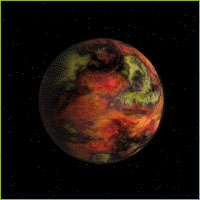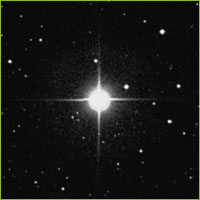
|
|

|
Find the PlanetsThe dream of finding worlds beyond our solar system is now a reality. In 1992, Alex Wolszczan and Dale Frail announced the landmark discovery
of planets orbiting a distant pulsar. Three years later, Michel
Mayor and Didier Queloz ended the long quest to detect a planet
around a star like our own sun. The pace of discovery since then
has been astounding -- heralding nearly a dozen new alien worlds. Alex Wolszczan and Dale Frail announced the landmark discovery
of planets orbiting a distant pulsar. Three years later, Michel
Mayor and Didier Queloz ended the long quest to detect a planet
around a star like our own sun. The pace of discovery since then
has been astounding -- heralding nearly a dozen new alien worlds.
Now you can join the planet hunt by locating some of the brighter stars with known planetary systems on a map of the sky. If conditions are right, you might even spot the actual stars in the night sky. You Can't See Them -- But They're There Even with the most advanced telescopes, astronomers cannot image
the planets beyond our solar system directly. They see evidence
for their existence in the wobble of stars pulled by their
gravity. The movement is so subtle that it's difficult to detect
visually. So, some astronomers look for periodic shifts in the
frequency of a star's light -- using a technique called Doppler
spectroscopy. Other scientists listen to distant pulsars for the
telltale sign of an irregular beat. Even with the most advanced telescopes, astronomers cannot image
the planets beyond our solar system directly. They see evidence
for their existence in the wobble of stars pulled by their
gravity. The movement is so subtle that it's difficult to detect
visually. So, some astronomers look for periodic shifts in the
frequency of a star's light -- using a technique called Doppler
spectroscopy. Other scientists listen to distant pulsars for the
telltale sign of an irregular beat.Follow The StarsThe planets themselves may be impossible to see, but you can locate some of the stars at the heart of planetary systems. Knowing star names can point you in the right direction, because the name of a star often refers to its location within a constellation. For instance, 51 Pegasi, the first sun-like star to be found with an orbiting planet, lies in the constellation Pegasus. Whether or not a star can be spotted easily in the night sky
depends on its apparent brightness, or magnitude. Magnitude is
signified by a numerical value, and the dimmer the star, the
higher the number. The brightest star in the sky, Sirius, has a
magnitude of -1.5, while stars with magnitudes higher than about 4
are difficult or impossible to perceive with the naked eye. Whether or not a star can be spotted easily in the night sky
depends on its apparent brightness, or magnitude. Magnitude is
signified by a numerical value, and the dimmer the star, the
higher the number. The brightest star in the sky, Sirius, has a
magnitude of -1.5, while stars with magnitudes higher than about 4
are difficult or impossible to perceive with the naked eye.
The stars listed below are just at the border of visibility with the naked eye. With our limited vision, we can locate their approximate place in the sky, using constellations to guide the way. But to clearly pinpoint these stars, you may need binoculars or a small telescope. 70 Virginis
|
 See where Virgo lies on the
See where Virgo lies on the  See where Ursa Major lies on the
See where Ursa Major lies on the
 Pegasus, marked by its distinctive Great Square, is known as an
autumn constellation. See where Pegasus lies on the
Pegasus, marked by its distinctive Great Square, is known as an
autumn constellation. See where Pegasus lies on the
 See where Cancer lies on the
See where Cancer lies on the